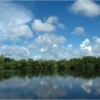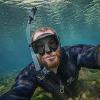Thanks for the detailed post! It was very helpful. I went to Brinson park. What part is public property and what is private there? It seemed like a very small area was actually the park and it ran behind a residential area with houses on either side. I mostly caught Gambusia. I think I may have caught a few hets but it's really hard for me to tell. The black markings are somewhat horizontal instead of vertical. Are there any places with a large, easy to catch population of hets? Maybe a swamp or something? I saw lots of interesting fish in the swamp area of gatorland including what I believe were sailfin mollies! I doubt I can collect there though and I don't feel like spending the entrance fee again just to collect. I would really like to bring back hets instead of gambusia. You guys have helped me out a lot so far but if you have any further advice, it would be much appreciated.
Probably none of us has ever been to Brinson Park. Well, except for Brian Zimmerman, that's one of his locations recently added to the FishMap application. Zooming in on the Google map, it's looks like his GPS spot is in the lake, in the vegetated area right in front of the parking. That seems like probable territory for Hets. Usually private property adjoining public parks is marked with private property and/or "posted" signs.
You probably caught some on your first foray there. Can you post a picture of your best prospect?
The fish you are most likely to catch there, possibly all on the same scoop of your net:
* Gambusia - primarily SCHOOL at the TOP. Active. Blue-ish tinge, over silver/gray/white. Not much markings. No hint of gold. No red anywhere. Black eye marking. Many will have prominent black "gravid spot." 1 to 2 inches. In many locations, one in 737 males will have a very easy to spot "salt & pepper" coloration.
* Heterandria - Not at the surface, down in the vegetation. Color olive/gold. Has a distinct red ring around a small black spot on front of dorsal. No hint of blue whatsoever. May or may not have black markings on side,but typically has a broad horizontal band with 6-10 very fine vertical lines. (Gambusia don't have anything like that.)
* Native molly - bigger than either gambusia or Heter, and faster. Even big adults may be in very shallow water. From above, have yellow line down the body. Males showing off will have a flashy blue or blue+orange tail, and some will show an oversized dorsal fin. In the hand, many females will have a rather bright yellow belly (and are fat.). Every scale will have a small black dot. Pointed molly face with lips. May try to jump out of your bucket or cooler.
Plus:
* Bluefin killie (Lucania goodei.) - Males have blue or red or orange (or occasionally yellow) dorsal and anal fins. Wide black side stripe, with zigzag edges. Females yellowish and usually have purplish tinge. Slightly deeper water.
* golden ear topminnow (Fundulus chrysotus) - in the vegetation. Golden flecks and/or red/metallic spots on body. May have red fins.
* flagfish. Mottled green/yellow/white. Murky dark spot on side. At about 1.5", males start developing stripes down the side that look kinda like an American flag, if it were green and orange. Babies under 1" hang out in extremely shallow water, in vegetation.
* Elassoma. Evergladei and okefenokee are local to the Orlando area. If you catch a tiny almost black fish with electric blue bars, that'll be one of the males. Females brown/purplish/tan with some mottling.
If you catch anything not listed above, send a picture. PM me if you want.











